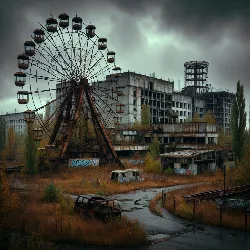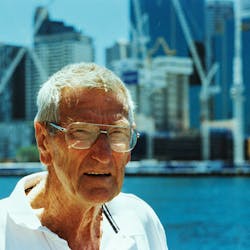
Level 1:
A long time ago, something bad happened in a place called Chernobyl. One of the big machines that makes lights and heat went boom! It was scary and dangerous. It made people and animals sick. People had to run away fast.
Today, we look back at the bad thing. We remember how people helped to make it less bad. Brave ones went close to the big scary machine. They saved a lot of people.
Now, something strange happened. Chernobyl is quiet. Only animals live there. But more and more people want to see this place. They want to remember the bad and the good. They also take pictures of animal friends.
But some people are not happy. They want others to remember the bad times. They say it is not a tourist place. But who’s to say what it should be? We will see.
Level 2:
The Chernobyl disaster was a nuclear accident that happened in 1986 and is considered one of the most disastrous in history. When reactor number 4 exploded, it shocked the world. Radioactive matter was spread throughout the surrounding environment, causing health problems and a mass evacuation. It’s a dark chapter in human history.
However, moving past the horrible incident, there were tales of bravery and sacrifice. Exposed to deadly radiation, thousands of people, also known as “liquidators,” worked to contain the nuclear fallout. They saved countless lives at great risk to their own. We remember and applaud them for their courage.
Interestingly, Chernobyl today has taken on a different appearance. It has become a ghost town, an eerie reminder of what happened. The Exclusion Zone is now populated only by wildlife. Yet, surprisingly, tourism has grown in recent years. People are coming in droves to see this historic site, explore the ghost town and photograph the thriving wildlife.
But not everyone agrees with this tourism boom. Some consider it disrespectful and inappropriate to turn a site of such tragedy into a tourist spot. Yet, others argue that it’s important for future generations to see and learn from past mistakes. The debate continues.
Full Story:
The incident at Chernobyl in 1986 is ingrained in history as one of the most catastrophic nuclear disasters the world has ever seen. When the fourth reactor at the Chernobyl Power Plant exploded, it raised alarms globally. The aftermath was devastating. Radioactive materials spread across vast areas, contaminating the environment and causing severe health problems. Entire communities had to evacuate, leaving behind their homes and lives.
Looking back at the terrifying incident, one can’t help but admire the tales of bravery that emerged. Thousands of men and women – the so-called Chernobyl “liquidators” – risked their lives in the face of lethal radiation levels. Displaying unparalleled courage, these heroes achieved the near-impossible task of containing the nuclear fallout, preventing an even more disastrous scenario.
Fast forward to today, Chernobyl presents a very different picture. Devoid of human activity, the abandoned Exclusion Zone transforms into an unexpected sanctuary for wildlife. Wolves, bears, moose, and numerous other species have seemed to reclaim these vast lands, painting a rather surrealist environment against the backdrop of human tragedy.
Interestingly enough, these desolated lands are finding a new kind of visitors – tourists. A surge in tourism interest has been registered in recent years, ignited partly due to international film and documentary presentations. People travel from all around the globe to see the dystopian spectacle, capture the eerie beauty of an overgrown ghost town, and witness the thriving natural life. As visitors walk among the decaying buildings, they are treading the line between a grim past and a strange yet hopeful present.
Yet, this phenomenon has sparked much debate and controversy. Critics argue turning such a profound site of human tragedy into a tourist attraction is insensitive and inappropriate. For them, the tourism boom seems to disregard the pain and loss suffered by thousands of people affected by the disaster.
Defending the rise in tourism, others believe that visiting Chernobyl serves as a crucial reminder of the vulnerabilities and the potential devastation of nuclear power. They argue that Chernobyl can serve as an important educational tool for future generations, urging humanity to take heed from past errors.
What the rightful fate of Chernobyl should be, however, rouses an unsettled debate. A testament to human error, a horrific aftereffect of technological failure, or a beacon of ecological revival – categorizing Chernobyl isn’t simple. Whether or not the increasing traffic of tourism is ethical remains in the hands of time and societal consensus.
Questions:
Question: What happened in Chernobyl in 1986?
Answer: In 1986, Chernobyl witnessed a catastrophic nuclear disaster when the fourth reactor exploded. The explosion resulted in the spread of radioactive materials in the surrounding environment, causing a mass evacuation and severe health problems.
Question: Who were the “liquidators” in the context of Chernobyl disaster?
Answer: The “liquidators” were the thousands of men and women who risked their lives to contain the nuclear fallout post the Chernobyl disaster. They played a vital role in preventing the crisis from worsening and saved numerous lives at great personal risk.
Question: How has the Chernobyl Exclusion Zone changed recently?
Answer: Today, the Chernobyl Exclusion Zone is a place devoid of human activity, inhabited primarily by wildlife. The abandoned area has unintentionally transformed into a wildlife sanctuary, with species like wolves, bears, and moose thriving.
Question: What is the controversy related to Chernobyl at present?
Answer: The present-day controversy around Chernobyl pertains to its transformation into a tourist hotspot. Many people visit this site out of historical interest, to witness the revival of wildlife, or to explore the ghost town. However, critics argue that it’s insensitive to turn a site of such tragedy and loss into a tourist attraction.
Fill in the Blanks:
accident, tale, catastrophic, explosion, reactor, courage, liquidators, wildlife, tourism, eerie, disaster, tourists, debate, critics, educational, spectacle, attractive, ghost town, hopeful, controversy, potential, ecological, decaying, communities
Chernobyl: An Unforgettable Tale of Tragedy and Triumph
The incident at Chernobyl in 1986 is ingrained in history as one of the most ________ nuclear disasters the world has ever seen.
When the fourth _______ at the Chernobyl Power Plant exploded, it raised alarms globally.
Moving past the horrible incident, there were tales of bravery and sacrifice.Exposed to deadly radiation, thousands of people - the so-called Chernobyl ”________” - worked to contain the nuclear fallout.
Devoid of human activity, the abandoned site transforms into an unexpected sanctuary for _______.
Interestingly enough, a surge in ______ has been registered in recent years, partly due to international film and documentary presentations.
Critics argue turning such a profound site of human tragedy into a tourist attraction is insensitive and inappropriate.
Others believe that visiting Chernobyl serves as a crucial ________ reminder of the vulnerabilities and the _______ devastation of nuclear power.
What the rightful fate of Chernobyl should be, however, rouses an unsettled _______.
Vocabulary:
Catastrophic: Highly disastrous; causing sudden and often large-scale damage or suffering.
Reactor: A device or installation in which nuclear fission or fusion can be sustained and controlled.
Explosion: A violent and destructive shattering or blowing apart of something.
Liquidators: In the context of Chernobyl, these were the individuals responsible for containing the nuclear fallout.
Ghost town: A deserted town with few or no remaining inhabitants.
Tourism: The activity of travelling to and exploring places, especially for pleasure.
Eerie: Strange and frightening.
Disaster: A sudden event that causes substantial damage or loss of life.
Tourist: A person who is traveling, especially for pleasure.
Debate: A formal discussion or argument about a specific topic.
Critics: People who express judgments about the value or quality of someone or something.
Educational: Providing education or related to the process of education.
Potential: Having or showing the capacity or possibility of becoming or developing into something in the future.
Ecological: Pertaining to or concerning the environment and its relationship with living organisms.
Controversy: Disagreement, usually prolonged, public, and heated, about a particular topic.



